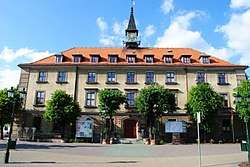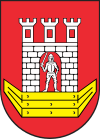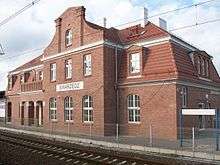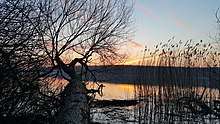Swarzędz
Swarzędz [ˈsfaʐɛnt͡s] (German: Schwersenz) is a town (miasto) in central Poland of 29,766 inhabitants and a mixed urban-rural commune (gmina miejsko-wiejska) of 40,166 inhabitants (2006 estimates). It is situated in the Poznań metropolitan area, in the Greater Poland Voivodeship (since 1999), having previously been in Poznań Voivodeship (1975–1998).
Swarzędz | |
|---|---|
 Town Hall in Swarzędz | |
 Flag  Coat of arms | |
| Motto(s): Dobrze trafiłeś / Good choice | |
 Swarzędz | |
| Coordinates: 52°24′30″N 17°4′17″E | |
| Country | |
| Voivodeship | Greater Poland |
| County | Poznań |
| Gmina | Swarzędz |
| Established | 14th century |
| Town rights | 1638 |
| Government | |
| • Mayor | Marian Szkudlarek |
| Area | |
| • Total | 8.16 km2 (3.15 sq mi) |
| Population (2006) | |
| • Total | 29,894 |
| • Density | 3,700/km2 (9,500/sq mi) |
| Time zone | UTC+1 (CET) |
| • Summer (DST) | UTC+2 (CEST) |
| Postal code | 62-020 |
| Area code(s) | +48 61 |
| Car plates | PZ |
| Climate | Cfb |
| Website | http://www.swarzedz.pl |


General
The town lies directly on the route E92 and includes an aerosport facility run by the Poznań flying club, Wanda Modlibiowska. There are various companies based in the town, in particular carpentry and upholstering businesses. In addition a bicycle path from Poznań runs through the Dębiniec nature reserve and finally through the town to Pobiedziska.
History
The documentary evidence for a settlement on the site of modern-day Swarzędz comes from 1366. In 1377 there is mention of a rectory in the settlement.
Due to its advantageous location on the route from Poznań to Masovia the town developed well. The settlement was formerly in private ownership. Originally the property of the Łodziów family, from the 15th century it passed to the Górków family. In 1638 the town was granted town rights. In the 17th century, guilds for tradesmen and craftsmen were formed. In 1793 during the 2nd Division of Poland the town of some 2.508 inhabitants came under Prussian rule. In 1798 448 craftsmen lived in the town. Of these, 70 were cloth makers and 36 weavers. In 1807 Swarzędz became part of the Duchy of Warsaw, though when the Duchy collapsed in 1815, the town again fell under Prussian rule.
At the end of the 19th century carpentry flourished. In 1887 the town was connected to the railroad from Poznań to Września and thus received another important means of transport to other parts of the country, together with the road from Warsaw to Poznań. In 1919, after the First World War, Swarzędz was again returned to Poland, but was occupied by the Third Reich at the beginning of the Second World War. From 1941 to 1943 a labour camp for Jews was located here.
Places of interest
- There is an open-air museum (the Professor Ryszard Kostecki museum) relating to beekeeping across Europe, one of the branches of the National Museum of Agriculture in Szreniawa.
- In the neighbouring town of Uzarzewo there is a park from the 19th century with a farmstead constructed between 1860 and 1865. There is a Hunting Museum there.
- In the village of Wierzenica there is a wooden church, St. Nikolaus, dating from the second half of the 16th century. At the church is the grave of August Cieszkowski (1814–1894). Near the village there is a graveyard with graves dating back to the Bronze Age.
- The church of St. Martin in Swarzędz (18th century).
- Church of the Archangel Michael in Uzarzewo.
Local district
The Swarzędz municipality (Gmina Swarzędz) has an area of 102.09 km2, on which 40,166 people (2006 est.) live in 21 townships. These include:
| Name | German Name (1815–1918) | German Name (1939–1945) |
|---|---|---|
| Bogucin | Hammer | Thorshammer |
| Garby | Garby | Buckelfelde |
| Gortatowo | Gortatowo | Eberbach |
| Gruszczyn | 1815-1906 Gruszczyn 1906–1918 Heinrichswerder | Heinrichswerder |
| Janikowo | Janikowo | Wiesengrund |
| Jasin | Jasin | Ebenfeld |
| Karłowice | Vorwerk Karlowitz | Wittenau |
| Kobylnica | Kobelnitz | 1939–1943 Roßgarten 1943–1945 Kobelnitz |
| Kruszewnia | Kruszewnia | 1939–1943 Ludendorf 1943–1945 Ludendorff |
| Łowęcin | 1815-1906 Lowencin 1906–1918 Lowentschin | Jägerslust |
| Mechowo | Mechowo | Moostal |
| Nowa Wieś Poznańska | 1815-1906 Neudorf bei Schwersenz 1906–1918 Neudorf | Neuhausen |
| Paczkowo | 1815-1906 Paczkowo 1906-1918 Osthausen | Osthausen |
| Puszczykowo-Zaborze | 1815-1906 Puszczykowo-Zaborze 1906–1918 Karlskrone | Karlskrone |
| Rabowice | Rabowice | Reizenstein |
| Sarbinowo | Sarbinowo | Siewershausen |
| Sokolniki Gwiazdowskie | 1815-1906 Sokolniki Gwiadowskie 1906–1918 Falkenstern | Falkenstern |
| Swarzędz | Schwersenz | 1939–1943 Schwaningen 1943–1945 Schwersenz |
| Święcinek | Vorwerk Swiencinek | Vorwerk Soldan |
| Uzarzewo | Gut Usarzewo | Soldanshof |
| Wierzenica | Wierzenica | Oberbrunn |
| Wierzonka | Wierzonka | Waldhof |
| Zalasewo | Zalasewo | Reichelsfelde |
Most of the municipality's population, however, live in its largest town, Swarzędz, which has a population of 29,766 and a land area of only 8.58 km2. It is the fourth most densely populated city (miasto) in Poland at 3,469.2 inhabitants/km2 (following Świętochłowice, Piastów, and Legionowo). It is also the most densely populated urban part of any Polish urban-rural gmina.
Notable residents
- Simon Baruch (1840 - 1921), German-American physician
- Erich Ludendorff (1865 - 1937), German general
- Philipp Jaffé (1819 – 1870), German historian
- Robert Siewert (1887 – 1973), German politician
- Aleksander Doba (1946 – present), Polish kayaker, 2014 Adventurer of the Year
External links
- Official website
- Much of the information contained in this article was translated from the German version
| Wikimedia Commons has media related to Swarzędz. |